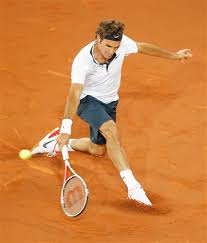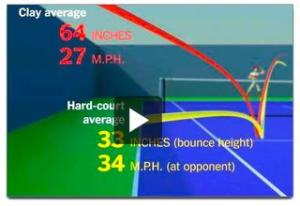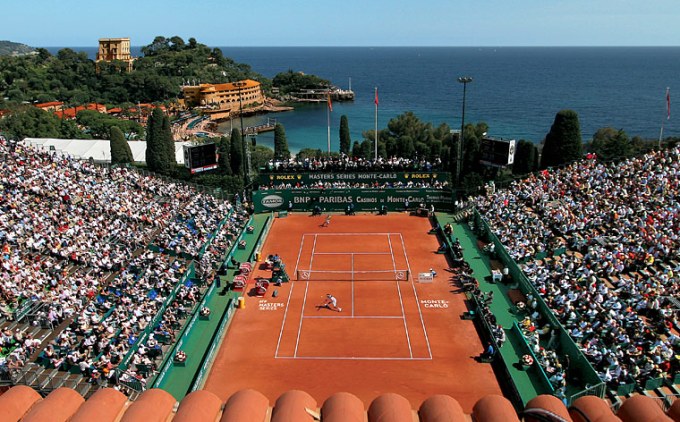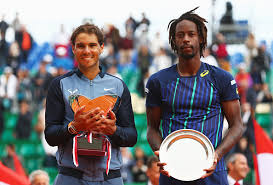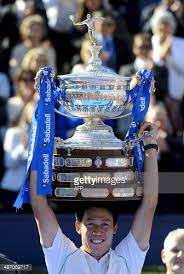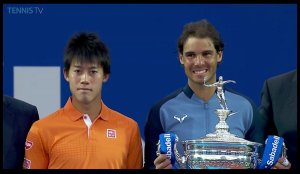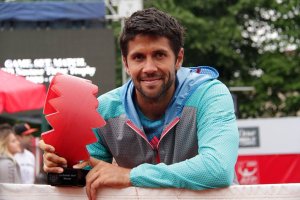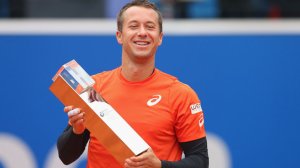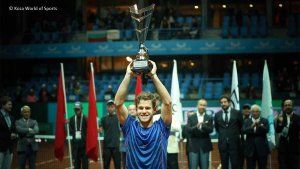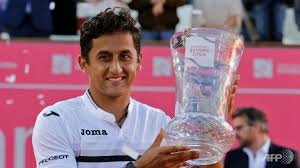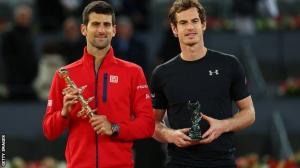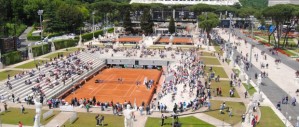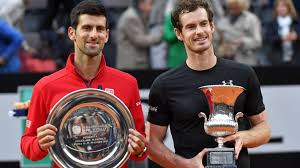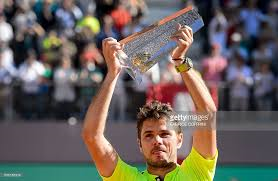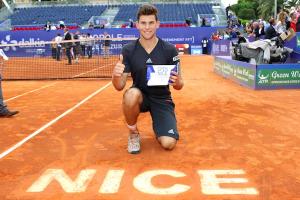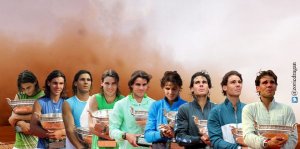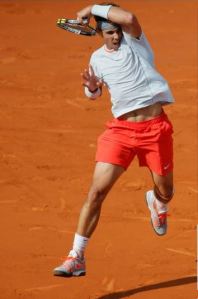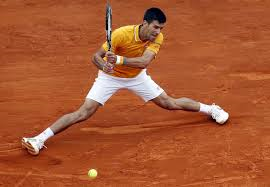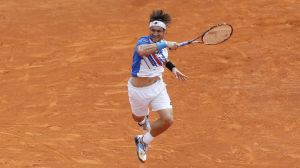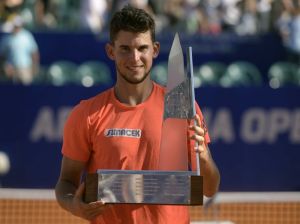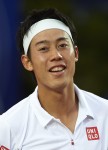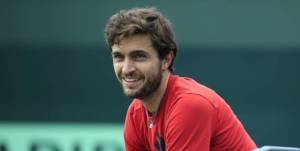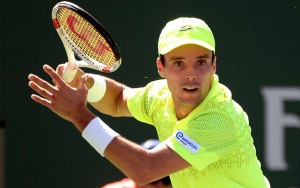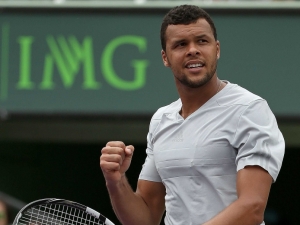(Photo by @puepppy.)
What follows is a revised and updated edition of Red Dirt Ballet…, originally published in 2016. I hope you enjoy it!
In April, professional tennis players change their shoes.
Gone are the standard smooth “tennies” designed for comfort on hard courts. In their place are textured soles optimized for traction on loose red powder.
A whirlwind of travel that carries players through the summer heat of Australia and South America, and sets them down in March on the hard courts of North America, delivers them in April to the “red dirt.” There they contest a series of clay court tournaments that culminates in the French Open.
Over the course of seven weeks, in nine countries, on three continents, players are tested in what many fans consider the purest form of tennis – where the surface imparts no advantage to raw power, where players must be proficient at every aspect of the game (serve, return, groundstrokes, volleys, and defense), and where players face the greatest physical and mental demands of the year.
What is the “clay”?
The “clay” in a modern clay court is typically crushed brick layered upon a gravel base to improve drainage. The court’s top layer is a fine red powder.
Much as an ice rink is smoothed periodically by a Zamboni, a clay court is swept to rid the surface of footprints, skid marks, gouges, and ball marks. Usually, a clay court is swept after every set and sprayed with water as needed to prevent the top surface dust from blowing.
What makes clay court tennis special?
The key characteristics of a clay court, from a player’s perspective:
- It is slippery.
Movement on a clay court is night-and-day different from movement on the hard courts on which professionals spend most of the year. Stopping, starting, and changing direction are all made more difficult by the court’s dusty top layer. Balance becomes especially critical.
The slipperiness influences tactics (for example, it’s especially profitable on clay to aim a shot behind a moving opponent) and profoundly affects a player’s timing. The most adept claycourters learn to slide into their shots.
- The ball’s bounce is relatively high.
Clay rewards players who use heavy topspin (i.e., forward spin), because it gives topspin shots a high bounce. (By contrast, on grass courts and many indoor hard courts, top-spinning balls tend to say low.)
The high bounce can throw off an opponent’s timing and/or place the ball above an his optimal “strike zone,” in either case making it difficult for an opponent to return a topspin ball with power and accuracy.
- When the ball strikes a clay court surface, it always leaves a mark.
At clay tournaments, players cannot ask for computerized “Hawkeye” challenges, because every shot leaves a mark. Instead, players can summon umpires out of their chairs to check ball marks.
In rare cases, a player might compel a cameraman to photograph a mark.
- Play continues on a clay court in light rain.
Clay is the only outdoor tennis surface for which light rain does not suspend matches. (Heavy rain, such as that which interfered with the 2012 French Open men’s final, makes play impossible.)
In rainy conditions, a clay court becomes soggy. Bounces slow down. Balls become waterlogged and heavy, coated with mud. The dry-slippery court surface becomes sloppy, forcing players to modify their footwork.
Clay court tennis requires players to adapt to a wider range of conditions than they would ever encounter during matches on either grass or hard courts.
- The surface is “slow.”
When the ball strikes a clay court surface, the friction between the ball and the clay grips the ball for an instant, providing the opponent an extra fraction of a second to reach the ball. (By contrast, grass courts and many hard courts are “fast.”)
Consequently, it is much more difficult on clay than on a hard or grass court for a player to hit an unreturnable shot. Matches are both physically and mentally arduous on clay.
Clay rewards players with good defensive skills (i.e., the ability to chase down opponents’ shots and keep a ball in play). Some of the tour’s most proficient claycourters, including Rafael Nadal, Novak Djokovic, David Ferrer, and Diego Schwartzman, excel at forcing their opponents to hit “one more shot” and eventually miss.
Defense alone, though, is not sufficient to guarantee wins. Those who succeed on clay know when and how to hit an aggressive shot that either takes control of a rally or wins a point outright.
Clay rewards decision-making, shot-selection, problem-solving, patience, and the vanishing art of point construction – the chess match wherein each player tries to think several shots ahead and outmaneuver his opponent to make space on the court for a winning shot.
Executed well, clay court tennis offers both breathtaking athleticism and fascinating drama.
The Spring Clay Court Season
The marquee event of the clay court season is the French Open, second of the year’s four Major tournaments, held at Roland Garros in Paris. To ensure that players reach Roland Garros in optimal clay court form, the tennis tour devotes seven weeks to warm-up tournaments in the U.S., North Africa, and Europe.
Week 1: Houston and Marrakech
The men’s clay tennis season opened in the week of April 8 with 250-level (i.e., fourth tier, if the Majors are first-tier) tournaments in Houston and Marrakech. Since most of the top players sit this week out to train for more prestigious events to come, young rising stars and experienced middle-ranked journeymen dominate the draws.
Tournament: Grand Prix Hassan II (Marrakech)
Category: 250
Singles field: 32
Top seed: Alexander Zverev (current ranking: #3)
Defending champion: Pablo Andujar
Trivia: Contested in Casablanca until 2016, this tournament is the only ATP event held in Africa.
Tournament: Fayez Sarofim & Co. U.S. Clay Court Championship (Houston)
Category: 250
Singles field: 28
Top seed: Steve Johnson (#39)
Defending champion: Steve Johnson
Trivia: This is the only ATP clay court event held in the U.S.
Some members of the hosting tennis club open their homes for the week to players.
Week 2: Monte Carlo
Leading off the European series is the Monte Carlo Rolex Masters tournament. First played in 1897, this Masters 1000 event (one tier below the Majors) offers fans and players alike the most beautiful venue of the year.
Rafael Nadal won eight consecutive titles in Monte Carlo, from 2005 through 2012, a feat that might never be equaled. Currently, Nadal owns a record 11 Monte Carlo titles.
Tournament category: Masters 1000
Singles players: 56
Top seed: Novak Djokovic (#1)
Defending champion: Rafael Nadal
Trivia: A club restaurant overlooks the spectacular center court. Players must tune out a din of conversation and the clinks of porcelain and glassware during their matches.
Week 3: Barcelona and Budapest
During the week of April 22, some players who did not qualify for Monte Carlo will begin their French Open preparations at a smaller event Budapest.
Tournament: Hungarian Open
Category: 250
Singles field: 28
Top seed: Borna Coric (#13)
Defending champion: Marco Cecchinato
Trivia: Five weeks after winning his first-ever career title in Budapest last year, Marco Cecchinato upset Novak Djokovic at the French Open.
Most higher-ranked players will either sit this week out or contest a 500 (i.e., third-tier) event held at the Real Club de Tenis Barcelona – 1899, one of the oldest tennis clubs in Spain.
Barcelona’s crowds are the most polite of the tennis season.
Because Barcelona’s Open Banc Sabadell serves as the Spanish national championship, nearly every healthy Spanish player is in the field. Thirty-seven-year-old David Ferrer has said that a Barcelona title would mean as much to him as winning a Major.
Tournament: Barcelona Open Banc Sabadell
Category: 500
Singles players: 48
Top seed: Rafael Nadal
Defending champion: Rafael Nadal
Trivia: After hoisting one of the the heaviest trophies of the season, the tournament’s singles champion traditionally jumps into the club’s swimming pool.
(The trophy is no longer quite as formidable as in this 2013 photo, but it is still hefty.)
Week 4: Munich and Estoril
Week 4 serves as a break for most the top players and therefore offers opportunities for lower-ranked players to shine at 250s in Munich and Estoril.
Tournament: BMW Open by FWU (Munich)
Category: 250
Singles field: 28
Top seed: Alexander Zverev (#3)
Defending champion: Alexander Zverev
Trivia: By tradition, the singles champion dons Lederhosen before the trophy ceremony.
Tournament: Millennium Estoril Open
Category: 250
Top seed: Kevin Anderson
Defending champion: João Sousa
Trivia: Last year, João Sousa became the first Portuguese to win either this event or its pre-2015 predecessor, the Portugal Open.
Week 5: Madrid
Since the early 2000s, the lead-up to the French Open has included three Masters 1000 tournaments. Two of those three are the events in Monte Carlo and Rome. Until 2008, the third Masters 1000 on clay was held in Hamburg. Because of Hamburg’s inclement weather (and, most likely, some behind-the-scenes politics), the third clay Masters 1000 was moved to Madrid in 2009.
The Madrid tournament poses a unique challenge during the pre-Roland Garros swing: high altitude. The ball travels faster through the air in Madrid than at the sea-level events, and Madrid’s relatively dry air makes the court both faster and more slippery.
As a joint men’s and women’s event with limited court space, the Madrid tournament is known for its long competition days. Nearly every year there are matches that begin after 11 p.m.
Highlighting the 2019 Madrid tournament are a return and a farewell featuring two 37-year-olds: Roger Federer will use the event to return to clay for the first time since 2016, while Spanish veteran David Ferrer will close his career in Madrid in front of the partisan home crowd.
Tournament: Mutua Madrid Open
Category: Masters 1000
Singles field: 56
Top seed: Novak Djokovic (#1)
Defending champion: Alexander Zverev
Trivia: In 2012, the tournament used blue clay instead of traditional red clay. Although the contrast between yellow balls and the blue background was wonderful for television, the bleached-then-dyed clay particles created a treacherously slippery surface. Several players, including Djokovic and Nadal, announced that they would refuse to play the event again on blue clay.
Week 6: Rome
The week after Madrid takes the players back to sea level for the season’s third and final Masters 1000 event on clay.
Tournament: Internazionali BNL d’Italia
Category: 1000
Singles field: 56
Top seed: Novak Djokovic (#1)
Defending champion: Rafael Nadal
Trivia: The tournament grounds feature a steeply raked stadium surrounded by classically-styled statues and located atop the site of the swimming venue for the 1960 Summer Olympics.
Week 7: Lyon and Geneva
The week before the French Open will find most of the top-ranked players in Paris practicing at Roland Garros, speaking to the media, and appearing at sponsor events. Meanwhile, 250-level events in Nice and Geneva offer final tune-up opportunities for middle-ranked players as well as a few hometown stars.
Tournament: Open Parc Auvergne-Rhone-Alpes (Lyon)
Category: 250
Singles field: 28
Top seed: John Isner (#9)
2018 champion: Dominic Thiem
Trivia: France, with five events including the Lyon tournament, hosts more ATP tournaments than any other nation in Europe.
Tournament: Banque Eric Sturdza Geneva Open
Category: 250
Singles field: 28
Top seed: Fabio Fognini (#18)
Defending champion: Marton Fucsovics
Trivia: Novak Djokovic’s coach, Marian Vajda, won the event in 1988.
Weeks 8 and 9: The French Open, Roland Garros, Paris
On 26 May, 128 men will begin the quest for the year’s second Major singles title at the French Open at Roland Garros. Fifteen days later, one man will hoist aloft the tournament’s storied trophy, the Coupe des Mousquetaires.
Because Roland Garros is the only Major site with no lighting for night matches, and since clay matches tend to be long, the French Open is the only Major whose first contests are held on a Sunday.
Every Major tournament offers compelling drama from the start. It is fascinating to watch players ranked 70 or 80 in the world, with no hope of winning the title, battle tooth-and-nail for the right to advance to the next round. Every day of the first week promises valor, heart, and sportsmanship.
One of my favorite tales of Roland Garros valor took place in 2013 and starred then-31-year-old Spaniard Tommy Robredo. Known as a tenacious fighter, and expert like many of his countrymen in the art of tennis on clay, Robredo outdid himself by coming back from two-sets-to-none deficits to win five-set matches in three consecutive rounds, a feat unmatched in the previous 86 years. After his third comeback, Robredo collapsed the court in tears as the stadium crowd chanted his name.
More drama, of the “never-a-dull-moment” variety, erupted later in the same event, when flare-wielding political protestors crashed the men’s final between Rafael Nadal and David Ferrer, spooking both contestants.
In addition to the French crowd’s perennial hope for a homegrown champion, the intrigue at Roland Garros 2019 features a cast of both veteran contenders and talented rising starsm, many of whom have fascinating storylines.
Tournament: French Open
Category: Major
Singles field: 128
Top seed: Novak Djokovic (#1)
Defending champion: Rafael Nadal
Trivia: The “footprint” of space around Court Philippe Chatrier, the main stadium court, is the largest of any tournament court in the world. The consequent extra running room is a great boon for players during baseline rallies.
The Contenders
It is highly probable that the man left holding the Coupe des Mousquetaires on June 9 will be one of a short list of favorites.
The King of Clay – Rafael Nadal
Thirty-two-year-old Spaniard Rafael Nadal is the greatest clay court player in the history of men’s tennis. Regardless of how the 2019 season unfolds, he is the undisputed King of Clay.
- Nadal leads all men in the Open Era with a staggering 90 percent of matches won on clay.
- In Best-of-5-Set matches on clay, his win-loss record is 106 – 2. 106, and 2.
- He won a record 81 consecutive matches on clay from 2006 to 2008.
- He won in excess of 50 consecutive semifinal matches on clay from 2008 to 2015.
- In 2017 – 18, at the age of 31, he set a record for consecutive sets won on any single surface with 50 straight sets won on clay.
- The only male player to have won 10 or more titles at any event, Nadal owns 11 trophies at each of *three* clay tournaments of different tiers: Barcelona (500), Monte Carlo (1000), and Roland Garros (Major).
Several attributes of Nadal’s unique playing style are especially well suited to the red dirt.
- The unmatched topspin he applies to his shots, especially to his forehand with the distinctive “lariat” follow-through.
- Excellent footwork, both relentless and precise.
- A deep understanding of tennis tactics and point construction.
- Formidable problem-solving skills.
- Great competitive intensity that wears down many opponents as Nadal plays every point as though it were his last.
In addition to his three “Undecimas,” Nadal has won four Madrid titles on clay (and one when the tournament was played on an indoor hard court) and eight Romes.
Nadal is no slouch on surfaces other than clay. He owns four titles, including two Wimbledons, on grass (which, fast and low-bouncing, is essentially the opposite of clay). On hardcourts, he has won nineteen titles, include three US Opens and one Australian Open.
Nadal’s career has been plagued by injuries. Custom arch supports he adopted in 2006 to protect a congenitally deformed bone in his left foot have wreaked havoc on both of his knees. He suffers from chronic patellar tendonitis and often plays in pain.
Over his 16 years in the ATP Top 100, Nadal has missed more than 24 months of competition and nine Major tournaments due to injuries. Notwithstanding, he has remained in the ATP Top 10 every week since he joined in the Top 10 in the spring of 2005.
Today, in the words of Nadal’s characteristically blunt uncle and first coach, Toni Nadal, “Rafael is not a tennis player but an injured person who plays tennis.”
At hard court events, which comprise two-thirds of the ATP tour, Nadal seems almost a tragic figure – equipped at age 32 with some of the tactically smartest tennis of his career, eager and determined to play, but much of the time thwarted by his body. Of the 21 hard court events he has been scheduled to contest since September of 2017, Nadal completed five tournaments (winning two and finishing two as runner-up), retired injured from five, and withdrew in advance due to injury from eleven. Sudden stops and violent accelerations on concrete are brutal for chronically injured knees.
Clay, with its forgiving, powdered softness, is blessedly different.
Nadal opened 2019 by reaching the Australian Open final without dropping a set only eleven weeks after pre-season ankle surgery. In March, he played well through four rounds on the Indian Wells hard courts before being forced to withdraw injured (again) before his semifinal match. He skipped the Miami hardcourts to recover and commence training on clay.
What can one expect from Nadal on the clay his year?
As is his wont, he will respect every opponent he faces.
We can count on him to play every point as though his life depended upon it.
Along the way, he may well win some titles.
The “Prince of Clay” – Dominic Thiem
Twenty-five-year-old Austrian Dominic Thiem has a powerful, aggressive game ideally suited to clay. Thiem imparts speed and blinding spin to both his his forehand and his gorgeous one-handed backhand, enabling him to push his opponents back even when he himself is well behind the baseline.
Many fans view Thiem, the 2018 French Open runner-up, as Nadal’s heir apparent on clay, because Thiem has won eight of his 12 career titles on the red dirt, and because Thiem is the only player to have beaten Nadal on clay in the last two years (in Rome in 2017, and in Madrid in 2018).
After struggling to adapt his big strokes to faster surfaces, Thiem has finally realized his potential on hard courts in the last six months. His match against Nadal on at the 2018 U.S. Open – in which Thiem blew through the first set 6-0 and finally succumbed by only a whisker in a fifth-set tiebreak – was voted by fans the best match of the year.
In March, Thiem confirmed his ability to fight toe-to-toe with the best on a hard court by coming back from a one-set deficit to beat Roger Federer in the Indian Wells final.
As long as Thiem stays healthy, the question of his hoisting the Roland Garros trophy is one of “when” rather than “if.” He is a title threat at every clay court tournament he enters.
The Reigning World #1- Novak Djokovic
When in late January 31-year-old Serb and World #1 Novak Djokovic won the 2019 Australian Open final in straight sets over Rafael Nadal, speculation among tennis’ talkers coalesced around a new narrative: would Djokovic be able to win his second French Open in 2019, enabling him to capture four consecutive Major titles for the second time in his career? Fashionable wisdom screamed, “Yes!” Typically hyperbolic commentary from the likes of Tennis Channel’s Mary Carillo declared there was no reason to think Djokovic wouldn’t win every tournament he entered for the rest of the season.
Then, in early March, Djokovic returned to competition, on his favorite surface, and proceeded to lose early – to #39-ranked Philipp Kohlschreiber in the Round of 32 in Indian Wells, and to #25 Roberto Bautista Agut in the Round of 16 in Miami. By all accounts, Djokovic was healthy and thus could not account for his unexpectedly weak performances with physical disability.
Because of his poor results in Indian Wells and Miami, Djokovic is not the current betting favorite for the French Open. He has titles from Monte Carlo, Madrid, and Rome as well as from Roland Garros, so he is capable of performing well enough to win. To do so, he would need more consistent focus and intensity that he exhibited on the hard courts in March.
Alexander Zverev
Twenty-one-year-old German Alexander Zverev plays with a well rounded game blessed with power he can summon from his 6’6″ frame. He has a big serve, decent returns, and strong groundstrokes from both wings. The only weakness in his game becomes clear when he plays at the net. (If/when he becomes a proficient volleyer, watch out!)
Zverev has already won three Masters 1000 titles, including clay titles in Rome and Madrid. Last year, he upset Djokovic on an indoor hard court to claim the year-end Tour Finals trophy. With multiple wins over both Djokovic and Federer (but none yet over Nadal on any surface), Zverev has been hailed by the press as a future star.
That said, Zverev has yet to perform well at a Major. He has reached only one Major quarterfinal, at the 2018 French Open.
Whether Zverev’s collapses at Majors have stemmed from nerves, from fitness problems, or from bad luck, it seems inevitable in light of his prodigious skills and talent that he will break through at a Major sooner or later. The 2019 French Open could be his time.
The 2015 Roland Garros Champion – Stan Wawrinka
Switzerland’s Stan Wawrinka, a thirty-four-year old veteran, is always a threat when healthy. Fueled by power in his serve, his forehand, and his lethal one-handed backhanded, Wawrinka’s game has carried him to two French Open finals and Major titles from Australia, Roland Garros, and the U.S. Open.
Wawrinka is on a comeback trail after two knee surgeries that sidelined him for half of 2017 and most of 2018. He might not yet be back to his best, but after six weeks of competition in April and May he could be ready for Roland Garros.
The Wildcards
It is unlikely that any of these players will be able to win the French Open, but each of them is skillful enough on clay to spice up the draw with upsets.
Roger Federer
Of the “Wildcards,” Roger Federer is the only player who might actually have the game to win the French Open (his second, after hoisting his first trophy in 2009).
Federer is vulnerable on clay for several reasons: because he completely skipped the clay in 2017 and 2018 and thus hasn’t played a clay match in nearly three years; because his one handed backhand is susceptible to attack from an opponent who adds heavy topspin to his groundstrokes; and because, though his shot variety is a rich as ever, at 37 he doesn’t move as well as he did when he was in his prime.
I would not pick Federer to beat a healthy Nadal, a healthy Djokovic, or a healthy Thiem, or any combination thereof, on clay. However, if Federer were to catch some “lucky” breaks – if Nadal, Djokovic, and/or Thiem were disabled, and if other dangerous opponents lost early – Federer could conceivably hoist the Coupe.
Kei Nishikori
With a playing style similar to Djokovic’s, Japan’s Kei Nishikori established himself solidly among the game’s Top 10 before suffering a series of injuries in the last two years. When he is healthy, Nishikori’s easy power and precise ball striking can carry him past any player. He has notched wins over Nadal, Federer, and Djokovic.
Two of Nishikori’s twelve titles have come on clay, both in Barcelona.
Like Wawrinka, Nishikori is on a comeback trail from injury. He is unlikely to have the physical resilience necessary to win one of the big clay titles this year, but if he stays healthy he could cause some early-round upsets.
Stefanos Tsitsipas
Twenty-year-old Greek Stefanos Tsitsipas made a big splash in Barcelona last year, when he beat several strong clay-courters (including Dominic Thiem) en route to the final, where he lost to Nadal. Three months later, he made an even bigger noise at the hardcourt Masters 1000 event in Toronto, defeating four Top-10 players, including Djokovic and Zverev, en route to the final (where again he lost to Nadal).
In Australia this year, he riveted the attention of the tennis world by defeating Roger Federer in the Round of 16.
Tsitsipas has a well-rounded, aesthetically pleasing game and a cockiness that serves him well on big stages. He may not yet have the physical stamina necessary to win seven best-of-five-set matches over two weeks in Roland Garros, but no one will be eager to see him across the net.
Roberto Bautista Agut
Thirty-year-old Roberto Bautista Agut is the rare Spanish player whose best surface is hard court rather than clay. Consistent, hard-working, and highly competitive, “RBA” (as he’s called in the tennis press) has steadily improved his game to a point where he can compete with the best. Two of his three career wins over #1 Djokovic have come in 2019 (in Doha in January, and in Miami in March).
Bautista Agut’s clean, well-rounded game is probably not strong enough to carry him to the trophy stand at any of the spring’s clay events, but he could serve as a spoiler.
Nick Kyrgios
Twenty-three-year-old Nick Kyrgios has three wins over Nadal (none on clay), two over Djokovic (both on hard court), and one over Federer (on clay in Madrid). The brutal efficacy of his unreadable serve is somewhat diminished on clay, but he can still be dangerous to anyone in the field if he plays well.
Diego Schwartzman
Both of Diego Schwartzman’s titles, including a 500 trophy in Rio in 2018, have come on clay. The twenty-six-year-old Argentine is one of the fastest movers and most skillful defenders on the ATP tour, and he can deliver remarkable power from his 5’7″ frame.
Schwartzman was one of only four players to take even a set from Nadal on clay last year (along with Thiem, Zverev, and Fabio Fognini). No one will want to have to face him this April and May.
Gaël Monfils
France’s best hope for a homegrown Roland Garros title is also an almost universally loved player on the ATP tour, the highly entertaining 32-year-old Gaël Monfils. Blessed with prodigious talent and staggering physical abilities, Monfils has reached the final at Monte Carlo and the quarterfinals at Roland Garros.
It is unlikely that he can win any of this year’s big titles, but he could produce impressive runs to please both his coaches and the crowds.
Karen Khachanov
Twenty-two-year-old Karen Khachanov of Russia can be a joy to watch on a tennis court if one is not rooting for his opponent. Khachanov’s blistering power and big serve have garnered him some impressive results. Two of Nadal’s closest and hardest fought matches over the last eighteen months have come against Khachanov (at the 2018 U.S. Open and last month in Indian Wells). Against Djokovic, Khachanov scored an upset on an indoor hardcourt to win the Paris Masters title last November.
In part because he has struggled with health issues, Khachanov opened 2019 with relatively weak results. If he is healthy for the clay season, he could pose a stiff challenge to any opponent.
Nikoloz Basilashvili
Twenty-seven-year-old Georgian Nikoloz Basilashvili currently sits at a career-high ranking of 17, after a year in which he won his first two titles. Both titles came at 500-level tournaments. One was on clay (in Hamburg last July).
Playing with a bazooka-hitting style similar to Khachanov’s, Basilashvili is capable of playing wonderful matches en route to a Round of 16 finish or perhaps even a quarterfinal. If he gets a top player on a down day, he could pull an upset.
The Youngsters: Borna Coric, Alex de Minaur, Frances Tiafoe, Denis Shapovalov, Félix Auger-Aliassime
Gallons of ink have been spilt about these five rising stars. Instead of detailing and extolling the achievements and virtues of each, I will note that they have all earned special mention. Individually and as a group, they are better than any generation in men’s tennis since Nadal/Murray/Djokovic. None of them is likely to hoist a big trophy between now and early June, but within three years it is they who will contest Major finals.
Who will win?
I don’t make predictions. 🙂
Quote for Today
“If” doesn’t exist in sport. That’s the real thing. If, if, if – never comes. The thing is, you have to do it. – Rafael Nadal

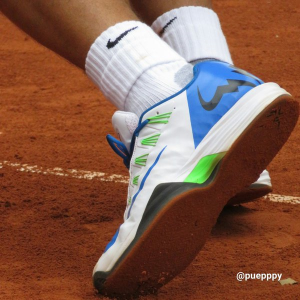
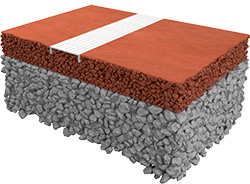
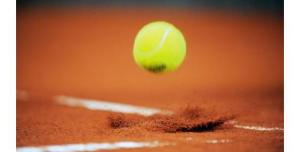


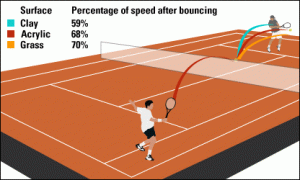












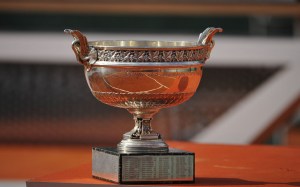
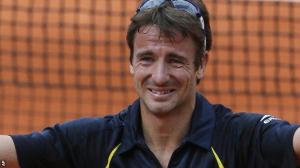






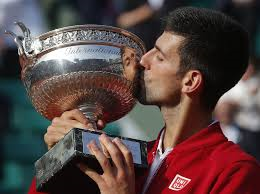

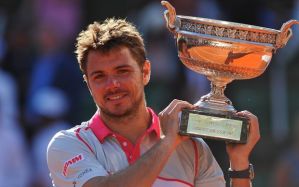
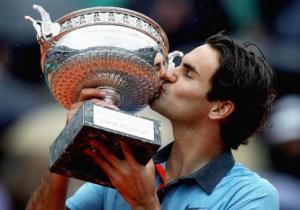












 (With 6’8″ Jerzy Janowicz after the 2012 Paris-Bercy final.)
(With 6’8″ Jerzy Janowicz after the 2012 Paris-Bercy final.) (With John Isner in Madrid.)
(With John Isner in Madrid.) (Meme created by @bellezavitale)
(Meme created by @bellezavitale) (With Feliciano Lopez.)
(With Feliciano Lopez.)

 (“The Armada” in Valencia.)
(“The Armada” in Valencia.)




 (Posted by David Ferrer.)
(Posted by David Ferrer.)
 World
World



















